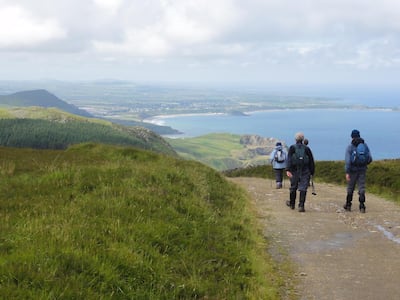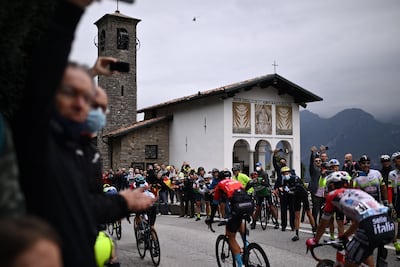Peace. That is the message of this year's UN World Tourism Day, which is marked on September 27. This year's theme – tourism and peace – is a reflection of rising global tensions and the state of the world, which have perhaps contributed to the growth of “pilgrimage travel”.
The Camino de Santiago in Spain is one of the world's most famous pilgrimages. More than half a million travellers walked its well-worn trails in 2023, a record high for the ninth-century route. New walking and hiking routes, such as Sri Lanka's recently opened Pekoe Trail, are creating more opportunities for nature-focused pilgrimages or spiritual travel, with religious devotion no longer a necessary element.
Historic pilgrimages around the world can feed a desire for simpler, deeper and more profound experiences. Such adventures used to lure kings, saints and nobles, but are now luring more tourists even as a plethora of new trails, treks and caminos emerge.
Instead, travellers embark on these journeys to discover history, pause for reflection and immerse themselves in nature. Blending wellness, physical activity and local experiences, pilgrimage travel is about simplicity, humility and purpose – the three hallmarks of traditional pilgrimages – and is an open invitation for people of all faiths, or none, to discover a different side of a destination.
Here are seven pilgrimage paths and destinations worth considering.
Zagros Mountain trail in Iraq's Kurdistan

The Middle East has a deep-rooted culture of walking, from historical pilgrimage paths to following in the footsteps of traditional nomads and shepherds. A new long-distance hiking trail in the Kurdistan region of Iraq is encouraging travellers to see a different side of the country. The Zagros Mountain Trail is a 215km route that connects remote communities using ancient pilgrimage routes and trading paths, finishing at the foot of Iraq’s tallest peak, Halgurd Mountain.
Those keen to explore the route can book a 15-day pilgrimage with Untamed Borders in April 2025. It will take in lush valleys, deep canyons, towering mountain passes, idyllic waterfalls and the Great Zab River. Travellers can also visit the Unesco World Heritage site Erbil Citadel, one of the oldest continually inhabited places on Earth, as well as the spiritual home of the Yazidi people, in Lalish.
Japan’s three sacred mountains of Dewa

A unique pilgrimage awaits in Japan’s Yamagata Prefecture, among a trio of mountains considered to be among the holiest places in the country. Here, among the peaks of Mount Haguro, Mount Gassan and Mount Yudono, believers of Japan’s Shugendo visit each mountain slope as a way to ask for rebirth.
The region blends esoteric Buddhist beliefs with the worship of nature, and pilgrims recite prayers centred around health, nature’s ecosystems and world peace. Travellers of any faith or nationality are welcome on the journey, and temple lodgings run by white-clad Yamabushi mountain priests make for unique places to stay.
Travellers can see a number of sacred sites in the prefecture, including a shrine of Prince Hachiko, who first opened up the Dewa Sanzan for spiritual worship, and a small lake where archaeologists have recovered artefacts from pilgrims dating back to the eight century. The best time to visit is between July and mid September when all three shrines are open.
Seven saints of Marrakesh

Morocco is a destination steeped in legend and the bustling former imperial city of Marrakesh is full of rich stories and folklore. In the heart of the city, near Bab Doukala, is a structure of seven pillars erected in honour of the seven saints of Marrakesh.
These historical Muslim figures were renowned for their piety and spirituality. Away from the shrine, the actual tombs are dotted across Marrakesh and form the basis of a centuries-old pilgrimage.
Taking seven days, the trip allows travellers to visit one tomb per day, traversing through the labyrinth-like streets of the Medina and leaving touristy areas behind to discover the ancient tombs and the stories that helped shape the face of modern-day Marrakesh.
“While the pilgrimage is not as widely followed as it once was, we recognise the importance of preserving and celebrating Moroccan traditions – and invite guests to make the Red City their own with a ziyara to the tombs of the seven saints,” says Alain-Thomas Briere, general manager at the city's Mandarin Oriental hotel.
Mountain views on the North Wales Pilgrim's Way

Wales has its own camino. The nature-laden 218km trek through the mountains of the north starts at Basingwerk Abbey in Flintshire and is part of a network of Cistercian settlements that once dotted the country. The route includes prehistoric stone circles, ancient churches, 1,000-year-old stone crosses and sacred waterfalls, and finishes at Bardsey Island in the Llyn peninsula.
Known as the island of 20,000 saints, it has been the focus of pilgrimages since Saint Cadfan founded a religious community there in the sixth century. Today, it is also a national nature reserve. Travellers visiting between March and October can see choughs, grey seals, puffins and manx shearwaters.
Our Lady of the Rocks in Montenegro

Surrounded by bright turquoise waters off the coast of Perast in the Bay of Kotor is a small island called Our Lady of the Rocks. Shrouded in legend, history and religion, the little Montenegrin islet attracts travellers from around the world to pay tribute.
The story goes that, in 1452, a local fisherman found an icon of Madonna and Child on a rock in the sea. To mark the discovery, locals built the small island that has grown each year as the townspeople perform an annual ritual that keeps adding more stones to the island. The only building is a Roman Catholic church, which is open to visitors of all faiths, with locals regularly ferrying travellers across on their boats.
The church hosts masses and houses a seafaring museum depicting treasures from the deep, plus some amazing art. It also has mementos from mariners across the world who visit Our Lady of the Rocks to ask for protection at sea or as a token of thanks for returning home safely.
Shrine of Madonna del Ghisallo in Italy

Cyclists can embark on a pilgrimage in Italy’s Magreglio region, where the Madonna del Ghisallo has become a must-visit location. This famous hill has long been a decisive stage for world-class cycling races such as the Tour of Lombardy and the Coppa Agostoni.
At the top of the hill is a 17th-century shrine containing a painting of the Virgin Mary, who is also known as the patroness of cyclists. Reaching the top of the hill also comes with a reward in the shape of the Madonna del Ghisallo Cycling Museum, a purpose-built and free-to-enter attraction open daily from March to November. Documenting and celebrating the history of cycling and the sport's transition to modernity, it is popular among travellers who have had their fill of the surrounding mountain vistas.
Ancient Inca Trail to Machu Picchu in Peru

Peru’s ancient Inca Trail, one of the world’s greatest treks, retraces the footsteps of the Sapo Inca people. Covering 39km and built by the Incas hundreds of years ago, the trail leads to the Sun Gate. It is the same gateway to Machu Picchu that the Incas used and comes with panoramic views of the complex.
Frequented by thousands of people every year, the journey takes about four days and encompasses cloud forests, mountain passes and flowing white rivers, plus a host of lesser-known but equally impressive Inca sites such as Winay Wayna.
Although this pilgrimage is expensive – those completing the trek must pay for permits, certified guides and camping access – a percentage of the money goes directly to supporting the indigenous Quechua community who are direct descendants. It’s also the only way to guarantee a crowd-free visit to Machu Picchu, as trekkers get access to the ancient site ahead of day-trippers.


